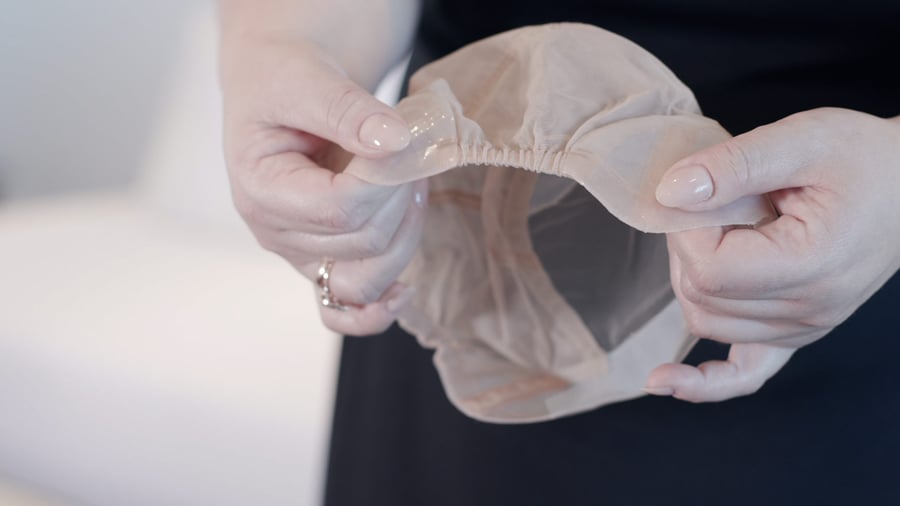5 Signs It’s Time To Replace Your Human Hair Wig

Are you noticing changes in your human hair wig that make you wonder if it's time for a replacement?
Does your wig no longer feel as comfortable or look as vibrant as it used to?
Understanding when to replace your wig is crucial for maintaining your appearance and confidence. In this article, we'll explore the five clear signs that indicate it's time to retire your current wig and select a new one.
To provide expert insights, we've collaborated with Erin, a seasoned stylist, and consultant at Nedia Salon in Minnetonka, Minnesota. Nedia Salon is a hair loss specialist center and Daniel Alain retail partner.
Erin brings a unique perspective not only from her professional background but also from her personal experiences. Having lost all her hair to alopecia at three years old, Erin has both worn and worked with wigs extensively, making her a trusted voice in helping women with hair loss find the perfect wig or topper for their needs.
Read on to find out more about the key signs it may be time to consider a new wig.

Sign #1 Your Wig Is Excessively Tangling or Matting
"Tangling is a common challenge," explains Erin from Nedia Salon. "Proper care can extend the life of a wig, but persistent tangling at the nape or from friction indicates that the hair may be deteriorating beyond what conditioning can restore."
A high-quality wig will certainly tangle less than a low-quality wig, but by its nature, human hair will tangle and mat if not adequately cared for.

To minimize tangles, we suggest always using a salon-grade cleansing shampoo and hydrating conditioner on your human hair wig. It’s also a good idea to give your piece a deep-conditioning treatment once a month to hydrate the hair, restore softness and shine, and smooth the cuticle layer.

We also recommend brushing your wig before and after every wear, with a detangling pin brush. Some of our customers like to keep a travel-sized brush in their purse or car, for frequent brushes throughout the day.
Storing your wig on a mannequin head or wig stand will also ensure the hair is kept tangle-free while it’s not being worn.
"If you're meticulous about care and still find the tangling unmanageable, it could be a sign of deeper issues with the wig's hair quality," Erin adds.
In an industry with no regulations about claims a brand can make about the quality of their hair, it’s unfortunately not surprising that some people end up spending a large amount of money on a low-quality wig that lasts no longer than a few months.
Some brands claim to use high-quality hair but in reality, it’s hair that has been over-processed and chemically-treated, then coated in a smoothing silicone treatment that makes the hair appear softer than it really is. After the first wash that removes the silicone layer, the hair will lose its luster and will become dry, brittle, and prone to snapping or tangling.
How can you really tell if a brand is making accurate claims about their wigs?
Before investing in an expensive human hair wig, no matter the brand, we recommend reading real customer reviews, and checking out what people are saying online about a brand’s piece. This should give you an idea of what to expect with any purchase and ensure that your wig lives up to your expectations for a piece.
Sign #2 Your Wig Has Noticeable Thinning
Hair loss in a wig can drastically reduce its volume and alter its style. "It's normal to lose a few hairs, but if your wig begins to thin out significantly, this affects not just the look but the confidence of the wearer," Erin points out.

Over time, a human hair wig may start to lose hair or density. You might notice hair in the hairbrush after brushing, decreased volume, uneven layers, or patchy areas where the hair is noticeably thinner than other parts of the wig. When a wig starts to thin significantly, it can lose its original volume and style, and look less natural.
Some ways to minimize thinning include gentle handling, especially when putting the wig on and taking it off. Our consultants at Daniel Alain recommend using the ear tabs to adjust the position of the wig and to avoid pulling or tugging on the hair.
Excessive heat styling may also cause a wig to lose density, so using a low to medium heat setting on blow dryers, straighteners, or curling wands, and using a heat protectant spray will minimize damage to the hair.

Sleeping in your wig can cause friction and stress on the hair, leading to breakage and thinning. We suggest removing your wig before going to bed and storing it properly.
While most companies do not offer wig repair services, at Daniel Alain, we pride ourselves on providing repair options for our Follea human hair wigs. Our skilled artisans can restore density and rejuvenate older wigs to ensure they look as lush and vibrant as when they were new.
For other brands, if your human hair wig has lost significant density, it may be time for a replacement.
Sign #3 Wig Cap Has Deteriorated
Cap deterioration is a common issue with older wigs, especially those made from lace or other delicate materials.
"A good cap should be invisible and flawless in its fit," says Erin. "If you start to notice stretching, tearing, or fraying, especially at stress points like the forehead and nape, it's time to consider cap repair or replacement."
When the integrity of the cap is compromised, not only can it become uncomfortable to wear, but it may also fail to provide the secure, snug fit that is essential for a natural look and comfortable daily wear.

Visible tears may be an issue, especially along the seams where the material may have stretched or been stressed beyond its limits. These tears can cause the wig to fit poorly and may lead to further damage if not repaired promptly.
In addition to tearing, a worn cap might show signs of fraying along the edges, particularly around areas that frequently come into contact with the skin, such as the forehead and nape. This fraying can make the wig uncomfortable to wear and less secure on the head.
Loss of elasticity is another sign of a worn cap, where the material no longer provides a snug, secure fit but instead feels loose and ineffective at keeping the wig properly positioned. This can drastically reduce the wig's stability, causing it to shift or slip during wear.
To protect the materials of a wig cap and ensure its longevity, it's important to handle and maintain it with care. Always store your wig on a proper wig stand or mannequin head when not in use. This helps maintain the shape of the cap and prevents unnecessary stretching or distortion.
Avoid exposing your wig to high heat, such as from hair dryers or styling tools, as heat can weaken the fibers and elasticity of the cap. When putting on or removing your wig, do so gently to avoid stretching the cap.
Regular washing is crucial, but it should be done carefully with mild, high-quality products to avoid harsh chemicals that can degrade the cap materials.
Repairs to the wig cap are possible for Follea wigs, and we encourage you to reach out to your consultant for more detailed information about our repair process.
Sign #4 Desire for a New Look, Length, or Color
As you become more experienced and confident in wearing wigs, you might find yourself wanting to change things up to reflect your evolving style or to experiment with new looks. This newfound confidence often leads to exploring different lengths, colors, or styles that perhaps seemed too daring or unfamiliar initially.
"Changing your wig is like refreshing your wardrobe—it can be a transformative experience that boosts your mood and confidence," Erin shares. She encourages clients to experiment with new styles and colors as their comfort with wig-wearing grows.

For anyone looking to try something new, Erin suggests a consultation to discuss various options that would suit their current needs and style preferences.
Sign #5 Your Hair Loss Pattern Has Changed
As your journey with hair loss evolves, so too might the type of hair solution that best meets your needs. If you've experienced a significant change in your hair loss pattern, it could be time to reassess your current hairpiece.
For those who have lost all their hair and are seeking a wig that offers comfort and security suitable for total hair loss, Follea Gripper wigs are an excellent choice. Designed with silicone patches, these wigs securely suction to the head without the need for adhesives or wig tape. This feature ensures that your wig stays firmly in place even during strenuous activities, providing peace of mind and a sense of freedom.

On the other hand, if you've noticed an increase in your hair volume, particularly on the top of your head, you might consider transitioning to a hair topper. Hair toppers are partial wigs designed to address less severe thinning or cover bald patches. They blend seamlessly with your existing hair, enhancing your hairstyle while covering any areas of concern with a natural look. Whether you're dealing with new growth or changes in hair distribution, a hair topper can be a versatile and effective solution to meet your changing needs.
"Whether you need something more secure like a Gripper wig or a lighter option like a topper, adapting to your hair's needs is crucial," advises Erin.
Is It Time to Replace My Wig?
Dealing with a human hair wig that no longer fits comfortably or looks as vibrant as it once did can be frustrating. Over time, you may have noticed changes like increased tangling, thinning, or even deterioration of the wig cap, each pointing to the natural aging of your wig. This can be a challenging realization, especially when you think about the investment and emotional attachment involved.
From what you've learned in this article, recognizing the signs that it's time to replace your wig is crucial not only for maintaining your appearance but also for ensuring your comfort and confidence.
Whether it's excessive tangling, noticeable thinning, cap deterioration, a desire for a new look, or a change in your hair loss pattern, understanding these signs helps you make informed decisions about when to consider a new wig or a different type of hair solution.
If you've recognized one or more of these signs in your current wig, it may be time to explore your options. Contact one of our consultants at Daniel Alain to learn more about our range of Follea human hair wigs and toppers, tailored to different needs and lifestyles.


.jpeg)